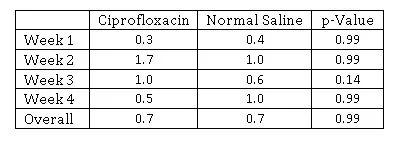Advertisement
Back to basics works

By Brandon Hopkins, MD, and Gabriel Gabarain, MD
Advertisement
Cleveland Clinic is a non-profit academic medical center. Advertising on our site helps support our mission. We do not endorse non-Cleveland Clinic products or services. Policy
Ear tube placement is the most frequently performed surgical procedure in children, approaching 670,000 cases per year in the U.S. alone. This important procedure can improve quality of life in patients with recurrent acute ear infections and can improve hearing in children with chronic fluid behind their ear drums. Although a very safe procedure, ear drainage after surgery is common and happens in up to 16 percent of patients during the first month after surgery.
Multiple approaches have been attempted to influence this drainage, with the most common being application of antibiotic ear drops in the days following surgery. This common almost universal treatment, although relatively benign, carries with it a significant financial cost. Each antibiotic drop prescription can exceed $60 and also carries the risk of sequelae, such as discomfort from the drops, allergic reactions, and the development of antibiotic resistance.
Other methods have also been proposed to address this issue and, as in many other areas of medicine, the trend has been towards more elaborate and costly interventions to bring the risk of complication to ever lower levels. This includes the use of topical applications to the ear canal, whether containing antibiotics, antibiotics and steroids, sterile irrigants or antiseptic irrigants. This has also led to the recent development of gel-based topical antibiotics, which remain in the middle ear for a prolonged period with the aim of decreasing ear drainage. As one would expect, this is a costly intervention.
At Cleveland Clinic, we are always looking at ways to improve patient care, decrease costs for patients and improve their overall quality of life. However, a more expensive mousetrap may not always be the answer. We have studied a “back-to-basics” approach for post-operative ear drainage by performing a side-by-side comparison of the typical application of antibiotic drops to that of normal saline drops in the ears after tube placement.
By looking at 200 patients undergoing ear tube placement with no infection at the time of surgery, we were able to see if there was any difference between the two treatments. What we found was very encouraging.
Using surveys to follow these patients, along with their one-month postoperative visit, we were able to see that the number of individual episodes of ear drainage (see chart), the number of days ear drainage was present, ear tube patency at follow-up visit, and quality-of-life impact from drainage (see table) are all statistically equal with both methods. In addition, we found that drainage in either arm of the study impacted a family’s quality of life minimally in the month after surgery.

Chart: Otorrhea Incidence: The overall incidence within the first four weeks after surgery was 23.9% for the normal saline arm and 16.7% for the ciprofloxacin arm (p=0.32). Chart 1 below illustrates the otorrhea incidence in total and on a week-by-week basis.

Quality of Life Effect: This table shows the Disruption Index (0 = not disruptive; 4 = extremely disruptive) of otorrhea events for each of the treatment arms on a week-by-week basis and in total.
We at Cleveland Clinic continually look for ways to maximize quality of life, minimize interventions, and maximize the care of our patients. Under those tenets, this study shows comparable efficacy of a simpler, more cost-effective approach using normal saline after ear tube placement.
In addition, we show that drainage, when present, minimally impacts a family’s quality of life. With this in mind, a less-is-more approach seems reasonable in the management of early ear drainage after ear tube placement. The use of normal saline can decrease healthcare costs for patients and reduce unnecessary use of antibiotics and the resultant development of resistant organisms.
Advertisement
Rosenfeld RM, Schwartz S, Pynnonen MA, et al. Clinical practice guideline: tympanostomy tubes in children. Otolaryngol Head Neck Surg. 2013;149(suppl 1):S1-S35.
Kocaturk S, Yardimci S, Yildirim A, Incesulu A. Preventive therapy for postoperative purulent otorrhea after ventilation tube insertion. American Journal of Otolaryngology 2005;26 (2):123–7.
Nawasreh OO, Al-Wedyan IA. Prophylactic ciprofloxacin drops after tympanostomy tube insertion. Saudi Medical Journal 2004;25(1):38–40.
Scott BA, Strunk CL. Post-tympanostomy otorrhea: a randomized clinical trial of topical prophylaxis. Otolaryngology – Head and Neck Surgery 1992;106(1):34–41.
Zacharia M, Robson A, Shinkwin C. Single dose antibiotic/steroid drop prophylaxis with ventilation tube insertion: a follow up study. Australian Journal of Otolaryngology 1993;1 (3):238–40.
Zipfel TE, Wood WE, Street DF, Wulffman J, Tipirneni A, Frey C, et al. The effect of topical ciprofloxacin on postoperative otorrhea after tympanostomy tube insertion. American Journal of Otology 1999;20(4):416–20.
Dr. Hopkins is a pediatric surgeon in the Head & Neck Institute; he can be reached at hopkinb@ccf.org. Dr. Gabarain is a resident in the Head & Neck Institute.
Advertisement
Advertisement

Looking at short-term outcomes in a high-risk population

Expanded patient criteria and surgical advances mean more patients can benefit

A multidisciplinary approach and individualized plan of care are imperative

Recommendations look to change mindset with CI referrals

Research aims to better understand the tumor immune micorenvironment

Research could help direct care pathways for patients with unexplained swallowing difficulties

Insight on larynx disorders and treatments

Novel procedures provide options for patients who can’t tolerate CPAP